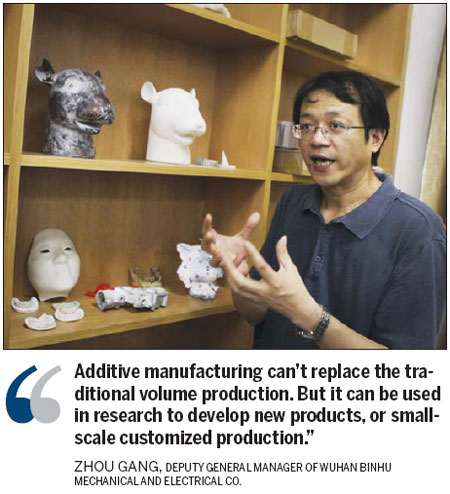Ventures into the third dimension
Updated: 2013-09-06 09:30
By Lyu Chang, Zhou Lihua and Todo Balazovic (China Daily)
|
|||||||||||
3D Printing technology prototypes Wuhan's future industrial model
China, the world's factory, is exploiting three-dimensional printing technology to help its manufacturers make high-end products.
Wuhan was an early adopter of 3D printing technology. The first Chinese 3D printer with independent intellectual property rights was developed in the city in 1994.
Now, Wuhan is riding the wave of the so-called third industrial revolution, to get a piece of the emerging 3D printing market that is expected to hit 10 billion yuan ($1.6 billion; 1.2 billion euros) within three years.
Mostly used in rapid prototyping of products, 3D printing, also known as additive manufacturing, adds layer after layer of material until the finished form is achieved.
Though the technology has not yet been deployed on an industrial scale, compared with injection-molding machines it vastly reduces time and costs at a click of a button.
"Parts are printed and fitted into the end use directly. They are printed on demand, so there is no need to hold inventory," says Jonathan Jaglom, Asia-Pacific vice-president of Stratasys, the largest 3D printing company in the United States.
With China's huge manufacturing base, Stratasys, along with many local companies, is looking to tech hubs like Wuhan to help develop and disseminate the technology, and is working with organizations such as the Asia Manufacturing Association to spread information on the benefits of the futuristic technology.
Jaglom says the country has the biggest potential globally for adapting the latest, most efficient forms of 3D printing technology.
"In the US and Europe it's catching on," he says. "In China it's even more huge. That base is growing and it's very exciting."
Currently, China makes up roughly 5 to 10 percent of Stratasys' overall international sales. Consumer models of 3D printers have recently been creeping onto shelves for use by hobbyists, priced at $1,089 (827 euros).
To capitalize on this huge potential, Wuhan, the capital of Hubei province, is establishing a 3D printing industry innovation center and technology industrial park in the Wuhan East Lake High-Tech Development Zone.
Wuhan Binhu Mechanical and Electrical Co, founded jointly by the local government, Huazhong University of Science and Technology and Shenzhen Innovation Investment Group, will move to the park. The company claims to be the first in the world to offer models with a printing size of 1.4 square meters.
Guiding a group through the showroom of the university's research center, Shen Qiwen, a senior researcher of 3D printing technology at Huazhong University of Science and Technology, demonstrates the process, tapping the keys of a computer attached to a printer. Seconds later, she produces a small plastic strip the size of a piece of chewing gum from a collection of white powder - the machine's equivalent of ink.
She goes on to describe how these machines will be crucial in the operations of the city's new high-tech zone.
"After the project is complete, a 3D printing technology transfer center and incubator will be established," Shen says.
"By then, a complete industrial chain will be formed from upstream to downstream that includes material suppliers, laser producers and even museums."
The project has already attracted heavy investment from companies involved in aeronautics, vehicle parts, heavy equipment and biomedicine.
Zhou Gang, deputy general manager of Wuhan Binhu, and a researcher at the Huazhong University of Science and Technology, says that while the potential applications for 3D printing are extensive, they will not substitute wide-scale manufacturing.
"Additive manufacturing can't replace the traditional volume production," Zhou says. "But it can be used in research to develop new products, or small-scale customized production."
Rather, he says, 3D printing technology in wide-scale use will enable manufacturers to shorten production cycles, better customize individual needs and cope with the production of complex or large-scale components.
The automotive sector is a particularly large consumer of the technology, as it allows for intricate modeling and scaling at a fraction of the price of previous technology and processes.
Zhou estimates prototyping an engine side panel for a truck using 3D printing technology would cost up to 500,000 yuan ($81,670; 62,000 euros), compared with about 2 million yuan for just the mold cast using traditional production methods.
The close proximity and cooperation between companies and consumers are ideal for hubs like Wuhan, where half the battle is just informing companies that this option exists.
"The idea is to have local manufacturing hubs within the central hub to help promote the new technology," Jaglom of Stratasys says.
"Getting local companies to embrace this technology - we're all for that."
Contact the writers through lvchang@chinadaily.com.cn

(China Daily European Weekly 09/06/2013 page19)
Today's Top News
List of approved GM food clarified
ID checks for express deliveries in Guangdong
Govt to expand elderly care
University asks freshmen to sign suicide disclaimer
Tibet gears up for new climbing season
Media asked to promote Sino-Indian ties
Shots fired at Washington Navy Yard
Minimum growth rate set at 7%
Hot Topics
Lunar probe , China growth forecasts, Emission rules get tougher, China seen through 'colored lens', International board,
Editor's Picks

|

|

|

|

|

|





